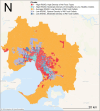Non-Linear Socioeconomic Inequality in the Distribution of Food Outlets in Metropolitan Melbourne and Regional Victoria, Australia
- PMID: 40653608
- PMCID: PMC12256645
- DOI: 10.1002/hpja.70074
Non-Linear Socioeconomic Inequality in the Distribution of Food Outlets in Metropolitan Melbourne and Regional Victoria, Australia
Abstract
Issue addressed: Socioeconomic disparities in food environments significantly impact diet quality and health outcomes, yet comparative evidence between metropolitan and regional areas remains limited. We examined spatial and temporal changes in food outlet availability in Victoria, Australia from 2019 to 2023.
Methods: Geospatial data from OpenStreetMap was used to classify food outlets into healthy, less healthy, and unhealthy categories. Outlet densities were calculated within 500 m (walkable) and 2000 m (short driving) buffers from Statistical Area Level 1 centroids. Socioeconomic disparities were assessed using the Index of Relative Socio-economic Advantage and Disadvantage quintiles. Gini coefficients quantified inequality, while Kruskal-Wallis tests, Dunn's post hoc tests, and k-means clustering identified socio-spatial patterns.
Results: In metropolitan Melbourne, both highly disadvantaged (quintile 1) and affluent areas (quintiles 4-5) had significantly higher densities of food outlets (e.g., 2.3 vs. 2.7 healthy outlets per 1000 people within 500 m in 2023), while mid-range socioeconomic areas (quintiles 2-3) had notably lower availability. Regional Victoria exhibited similar trends, with mid-range areas consistently underserved. From 2019 to 2023, Melbourne's Gini coefficients for healthy outlet access improved slightly (0.45-0.43), whereas regional areas worsened (0.52-0.55). Clustering revealed limited healthy food availability in disadvantaged rural clusters and high densities of unhealthy options in urban regional centres.
Conclusions: Food outlet availability in Victoria shows distinct non-linear socioeconomic disparities, disproportionately disadvantaging mid-range socioeconomic areas.
So what: Strategic urban planning and targeted policy interventions in underserved suburban and regional locations are essential for mitigating inequalities and promoting healthier communities.
Keywords: Australia; Melbourne; Victoria; food environment; inequality.
© 2025 The Author(s). Health Promotion Journal of Australia published by John Wiley & Sons Australia, Ltd on behalf of Australian Health Promotion Association.
Conflict of interest statement
The authors declare no conflicts of interest.
Figures


Similar articles
-
Obesogenic urban food environments in Santiago, Chile: Perceptions from a cross-sectional study of two socioeconomically distinct neighborhoods.Health Place. 2025 Jul;94:103493. doi: 10.1016/j.healthplace.2025.103493. Epub 2025 Jun 5. Health Place. 2025. PMID: 40479871
-
The community food environment and its association with diet, health or weight status in Australia: A systematic review with recommendations for future research.Health Promot J Austr. 2023 Apr;34(2):328-365. doi: 10.1002/hpja.679. Epub 2022 Dec 12. Health Promot J Austr. 2023. PMID: 36433658
-
Application of a geospatial query tool to characterise the community food environment and examine associations with dietary quality: evidence from three Chilean cities from the SALURBAL project.BMC Public Health. 2025 Jul 3;25(1):2311. doi: 10.1186/s12889-025-23392-x. BMC Public Health. 2025. PMID: 40610943 Free PMC article.
-
Do Patients of Different Levels of Affluence Receive Different Care for Pediatric Osteosarcomas? One Institution's Experience.Clin Orthop Relat Res. 2025 Apr 1;483(4):748-758. doi: 10.1097/CORR.0000000000003299. Epub 2024 Oct 30. Clin Orthop Relat Res. 2025. PMID: 39485923
-
Slum upgrading strategies involving physical environment and infrastructure interventions and their effects on health and socio-economic outcomes.Cochrane Database Syst Rev. 2013 Jan 31;(1):CD010067. doi: 10.1002/14651858.CD010067.pub2. Cochrane Database Syst Rev. 2013. PMID: 23440845
References
-
- Lake A. and Townshend T., “Obesogenic Environments: Exploring the Built and Food Environments,” Journal of the Royal Society for the Promotion of Health 126, no. 6 (2006): 262–267. - PubMed
-
- Rosenberg P., Global Report on Urban Health: Equitable, Healthier Cities for Sustainable Development, ed. World Health Organization (World Health Organization, 2016).
-
- Giles‐Corti B., Vernez‐Moudon A., Reis R., et al., “City Planning and Population Health: A Global Challenge,” Lancet 388, no. 10062 (2016): 2912–2924. - PubMed
MeSH terms
Grants and funding
LinkOut - more resources
Full Text Sources

